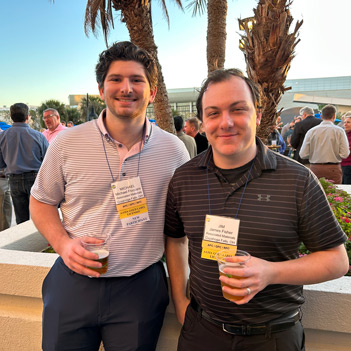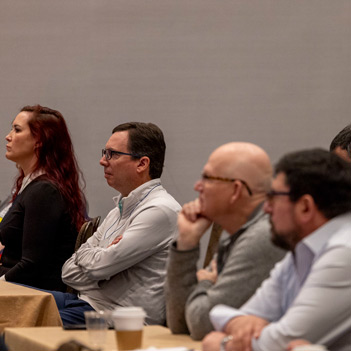


Whether attending your first FGIA conference or your third, we want to ensure that your time is well spent, and you are able to make the most of the networking, educational and committee opportunities at the event. Information related to the conference is provided below. Feel free to reach out to me directly with any questions you may have.
Angela Dickson
FGIA Marketing and Communications Director


Conference Structure and Guidelines
Three Conferences (each year)
- Annual – February or March
- Summer – June (virtual summit)
- Fall – September or October
Networking Opportunities
- Conference participants are encouraged to meet new industry representatives and connect with existing contacts during virtual receptions hosted at the end of the day on Tuesday and Wednesday.
- Participants can connect with others at the event, relay shared experiences or learn from peers.
- Virtual receptions and the annual awards ceremony are included in the conference registration fee.
Social Media
- FGIA members may use the event hashtag (#FGIAconf) during conferences to post interesting information from presenters or share photos of activities with fellow participants.
- Staff also live tweets from presentations, which is another way for conference participants (and those unable to attend) to stay engaged.
Attire
- Meetings and receptions during the conference are business casual.


About FGIA
FGIA is organized into three divisions known as the Architectural Products Council (APC), Glass Products Council (GPC) and the Residential Products Council (RPC) – all report to the Board of Directors. Products Councils consist of several product- or material-specific Councils that address technical, regulatory and marketing needs of that market segment.
The Association also supports Southeast and Western Regions, which address issues specific to the unique environments and building code requirements in their respective geographic areas.
View FGIA organizational structure.
Committee and Task Group Member Participation
Members may join any committees or task groups (except Steering Committees) by logging into the website and submitting your request or by notifying staff.
Ballot Voting Member
Individual receives all correspondence related to the committee/task group and is responsible for returning electronic ballots so that the required minimum number of responses is achieved.
Corresponding Member
Individual receives all correspondence related to the committee/task group with the option of commenting on electronic ballots.
Forming Committees/Task Groups
Groups may be formed when any member or group of members prepare and present a formal motion to the Council(s) under which the group will operate. The request must include a proposed name, scope, roster and Chair.

Leadership Positions
FGIA offers many leadership opportunities to members, allowing these individuals to grow professionally and to showcase their company’s involvement and expertise.
- Board of Directors
- Steering Committee rosters
- Council First and Second Vice Presidents
- Committee and Task Group Chairs, Co-Chairs and Vice Chairs
Council Designations
FGIA is broken into different product and material councils that serve the distinct interests of member companies. These councils meet at in-person conferences and during conference calls, as needed.
- AMC – Aluminum Material Council
- APC – Architectural Products Council
- DOOR – Door Council
- FMC – Fiberglass Material Council
- GPC – Glass Products Council
- RPC – Residential Products Council
- SKY – Skylight/Sloped Glazing Council
- VMC – Vinyl Material Council
- WIC – Wall Interface Council
- WCCMC – Wood and Cellulosic Composite Material Council
Steering Committees
The Board appoints committees to oversee specific areas of FGIA’s operation, which represent the interests of all members. Steering Committees differ from other committees and task groups in that rosters are appointed, and all roster participants must be Category 1 or GPC members. The following Steering Committees manage the primary operational areas of the organization.
- Certification Steering Committee (CSC) (inactive)
- Code Action Steering Committee (CASC)
- Education Steering Committee (ESC)
- Innovation Steering Committee (ISC)
- Marketing and Engagement Steering Committee (MESC)
- Regulatory Steering Committee (RSC)
- Sustainability Steering Committee (SSC)
- Technical Steering Committee (TSC)
Other Acronyms
As with any industry association, FGIA has its own acronyms. These have been included in a quick guide for easy reference.

Standards Development
AAMA and IGMA standards are developed in response to the needs of our member companies to solve critical issues in the industry. It takes the interest, energy and experience of our members to help support the development of these standards. It is effective collaboration and communication that make us strong, and your vote counts.
Voting During Conferences
During in-person conferences, voting is based on badge color which reflects each member company’s Council voting rights.
Balloting
Only one vote per eligible company membership is accepted per ballot. The member company’s main contact receives notification of all association and Council ballots.
All comments and disapprovals must have an explanation and must be formally addressed and resolved by the committee or task group.
Committee/Task Group Ballot
Members listed on committee and task group rosters are eligible to vote if their company has elected to support the Council under which the committee or task group operates.
Council Ballots
Once the committee or task group has come to a consensus on a draft of the document or project, it will be distributed for Council ballot to the main contact of each member company supporting the Council(s) to which the committee or task group reports.

Upcoming Events
Stay connected and informed. Mark your calendar for these important upcoming events.
View a PDF of the full list here.